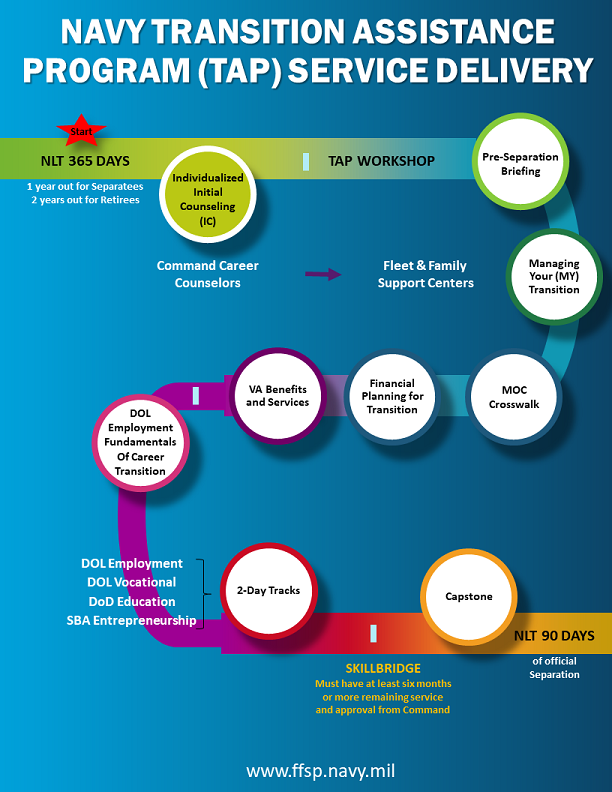Transition Assistance Program
The Transition Assistance Program (TAP) prepare eligible Service members and their families to face the many challenges of transitioning from active duty back to civilian life. TAP enables Service members to fulfill the requirements of the Veterans Opportunity to Work (VOW) to Hire Heroes Act of 2012 and meet their Career Readiness Standards (CRS) as mandated by the TAP for Military Personnel Department of Defense Instruction 1332.35.
Effective 1 Oct 2019, all transitioning Service members must attend Initial Self-Assessment Counseling (IC) no less than 365 days prior to official separation, which prepare them for their TAP Workshop that compass 3-days of core mandate curriculum and selected career tracks that focuses either on Employment, Entrepreneurship Education or Vocational training. Training is in a classroom setting but is available on Transition Online Learning (TOL) for Service members deployed or stationed in isolated areas. Military spouses are highly encouraged to attend TAP with their transitioning Service member.
History of Transition
In 1990, Congress established a program to assist transitioning Service members due to the mandate reduction in forces. The United States Army called the Army Career Alumni Program (ACAP) led the task. Shortly after in 1991, the National Defense Authorization Act (NDAA) established the Transition Assistance Program (TAP) and set forth 10 U.S.C, 1142, in means of minimizing any hardships of Service members transitioning from military to civilian life.
TAP overseen by the Office of Secretary Defense (OSD) and is a partnership with the following agencies:
- Department of Labor (DOL)
- Department of Education (DOD)
- Department of Veterans Affairs (VA)
- Small Business Administration (SBA)
- Office of Personnel Management (OPM)
- Military Civilian Transition Office (MCTO)
In 2011, the recommendations from the VOW Act’s mandates resulted OSD to redesign TAP to ensure that Service members and their families are better prepared to transition from the military.
From the VOW, emerged the Hire Heroes Act that makes several components of the program mandatory for all eligible service members who served at least 180 continuous days of active duty. From the outcome of the VOW, TAP restructured to Transition.
In 2014, TAP evolved and adopted the Military Life Cycle (MLC) model, so that transition assistance is a continuum through Service members’ careers. Within the MLC model, Service members receive an in-depth individual transition financial planning methodology.
While participating in TAP Workshops, Service members and their families are encouraged to take advantage of the additional trainings that best suits their career path from the military into civilian life.
Mandated Initial Self-Assessment & Pre-Separation Counseling
Effective 1 Oct 2019, all Service members transitioning from the military must complete a Congressionally Mandated Initial Self-Assessment within two years of retiring, within 18 months of separating, and not less than 365-days prior of official retirement or separation date; pursuant to 10 U.S.C. 1142. Service members are to contact a Career Command Counselor (CCC) or Transition Counselor for guidance and to learn about the Career Readiness Standards requirements of the transition process and completion of the DD 2648.
- The Navy Transition Assistance Program is designed to provide the most successful transition from military to civilian life by offering in-person and virtual classes. For in-person workshops, contact your local Fleet and Family Support Center. For virtual workshops, access mynavyfamily.com.
- Our partner organizations websites and transition resources can be access via the Military Civilian Transition Office website at https://tapevents.mil/.
Updated 5 February 2025